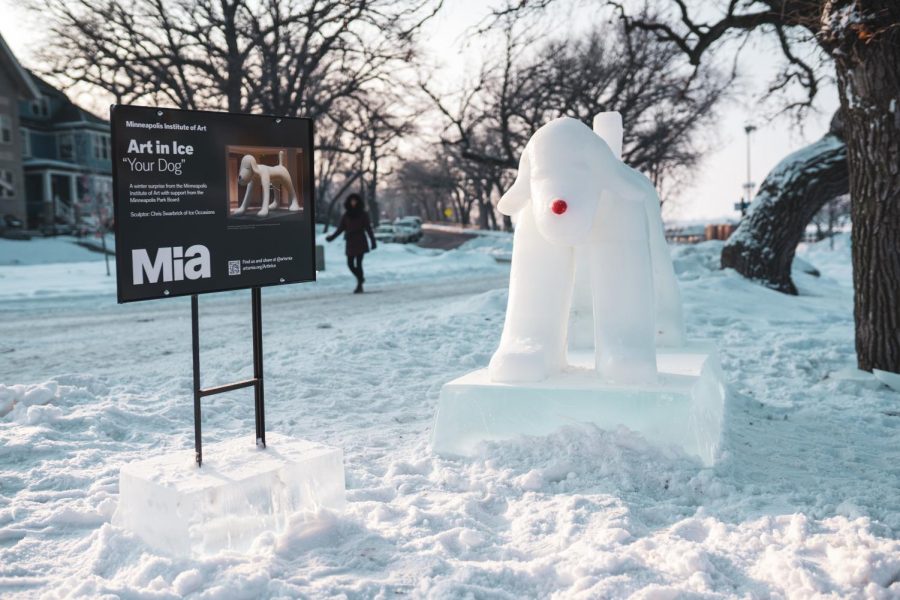Since the pandemic began, we’ve neglected our special indoor spaces – our old libraries, our quaint coffee shops, our favorite art museums – to stop the spread of COVID-19. But many are still missing the feeling of taking in an atmosphere where strangers huddle next to each other, sipping coffee, reading books or appreciating art.
That’s why the Minneapolis Institute of Art (Mia) decided to provide a literal and figurative breath of fresh air to its Twin Cities art lovers through its newest commission. The citywide public art initiative takes the most iconic pieces from Mia’s art collection and puts them in parks around the city.
The twist? Everything is ice.
“Art in Ice,” commissioned by Mia and created by Chris Swarbrick of Ice Occasions, will be available to view at four Twin Cities parks until Feb. 28, or until the works melt away. From the beloved “Celestial Horse” at North Commons Park to Salvador Dalí’s surrealistic “Aphrodisiac Telephone” at Boom Island Park, the works offer scavenging sculpture devotees or hapless passersby a piece of icy public art.
With the recent warmer weather, “Veiled Lady,” the sculpture at Longfellow Park, was taken down Monday for safety measures. The other four works, however, are still intact — with some of their details melted — and can be enjoyed until they fully melt away, said Katie Hill, Mia’s head of engagement strategy and coordinator of “Art in Ice.”
Behind the sculptures’ glossy sheen and chiseled beauty is a lot of heavy lifting and hard work, Swarbrick said.
The ice sculptures — 2,000 to 3,000 pounds each — take Swarbrick a few days to build and encompass many hours (three to four, on average) of planning and “Tetrising” the multiple ice blocks into a basic shape, drawing and sketching before the ice even hits the walk-in freezer Swarbrick sculpts in.
Then, using a chainsaw and a chisel, Swarbrick carves a picture into the blocks of ice. He’ll sand the shapes down, grind them and eventually torch them for that slick texture.
View this post on Instagram
Ice sculptures are popular all over the country, but in a state known for its chilly temperatures, the art has become a regional delight.
“Here we have the ability to do larger ice sculptures outside that will last,” Swarbrick said. But for how long they will last is a different story.
The sculptures thrive in 10- to 15-degree weather conditions; anything under or over those temperatures can do damage to the work. The ice becomes too fragile and cracks easily in negative temperatures, and the ice melts in higher temperatures. But part of the fun is the impermanence, Swarbrick said.
“There’s something very satisfying about creating something that you know isn’t gonna last,” Swarbrick said. “I mean, the beauty of it is that it’s temporary.”
Long-time Mia member Erica Anderson spent her weekend scouting out the sculptures, traversing around the city on public transit to see the public art. Anderson works from home, and after the sub-zero weather passed, making way for pleasant Minnesota temperatures, she felt like she needed to get out of the house and see the sculptures.
After hearing about the sculptures through Mia’s promotion on its channels, Anderson dedicated her weekend to viewing them.
Did they fulfill her expectations? “Oh, definitely,” Anderson said. “Veiled Lady” was Anderson’s favorite out of the five. “That’s always been my favorite at the museum, and I’ve loved seeing it in other forms.”
“We wanted to try something new that could offer a bright spot in a long winter and meet folks where they are,” Hill said. “People are spending more and more time outdoors, so we wanted to surprise and delight park-goers.”
Kathleen Smith also made it her mission to visit the sculptures this weekend. Bringing along her dog and her husband, she saw four out of the five sculptures.
To the sculptures, people brought their children, dogs and family members to take pictures and enjoy the art.
Smith said, “You don’t get to connect to the community as much now because we’re physically distanced, but it’s a good reminder that we are a small community and to kind of come together to enjoy these works.”














